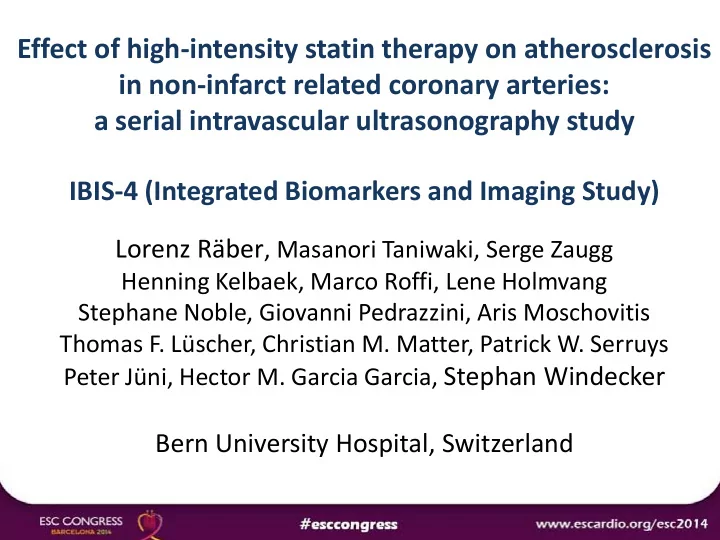

Effect of high-intensity statin therapy on atherosclerosis in non-infarct related coronary arteries: a serial intravascular ultrasonography study IBIS-4 (Integrated Biomarkers and Imaging Study) Lorenz Räber , Masanori Taniwaki, Serge Zaugg Henning Kelbaek, Marco Roffi, Lene Holmvang Stephane Noble, Giovanni Pedrazzini, Aris Moschovitis Thomas F. Lüscher, Christian M. Matter, Patrick W. Serruys Peter Jüni, Hector M. Garcia Garcia, Stephan Windecker Bern University Hospital, Switzerland
Speaker’s ¡name : Lorenz Räber, MD � I have the following potential conflicts of interest to report: � Research contracts � Consulting � Employment in industry � Stockholder of a healthcare company � Owner of a healthcare company � Other(s): X � I do not have any potential conflict of interest �������������������������������������� Swiss National Science Foundation ������� unrestricted grant by Volcano Europe, Belgium ���� Biosensors S.A., Switzerland ��
B ACKGROUND � Statins potently reduce cardiovascular events and IVUS studies have shown that high intensity statin therapy results in atheroma regression in stable CAD patients. � Acute STEMI remain have not been included in IVUS regression studies despite their higher risk for recurrent events and high frequency of vulnerable plaques typically extending beyond the culprit lesion. � Plaque phenotype is relevant in the pathogenesis of future events. Therefore, it is of interest to study changes in plaque composition in response to high- intensity statin therapy. H YPOTHESIS Coronary atherosclerosis regression can be achieved by the highest dose of rosuvastatin therapy (40 mg daily) in the proximal segments of non-infarct related arteries of STEMI patients within 13 months. Similarly, a reduction of RF-IVUS defined necrotic core and a decrease in the frequency of high risk plaque (thin cap fibroatheromas) can be achieved.
1161 Acute STEMI Patients Proximal part (>40 mm) 1:1 Randomization 2 major non-IRA vessels 103 Acute STEMI Biomatrix vs. BMS (COMFORTABLE AMI) Patients 11 international sites Inclusion 9/2009 - 1/2011 BL Rosuvastatin 20 mg 5 Sites (N=103) over 2 Weeks Bern (60) Copenhagen (21) Rosuvastatin Geneva (13) 40mg Lugano (6) over 13 Mo Zurich (3) 1° Endpoint @ 13mo FUP Change in % Atheroma Volume Change in % Necrotic Core
P RIMARY IVUS AND RF-IVUS E NDPOINT 1° IVUS EP Percent Atheroma Volume 43.95 ± 9.66 % 0 -0,2 -0.9% (-1.56 to -0.25) -0,4 P=0.007 -0,6 -0,8 43.02 ± 9.82 % -1 1° RF-EP Change Percent Necrotic Core Δ -0.05 % (-1.05 to 0.96), p=0.93 Baseline 13 Months F/U 21.14 ± 7.43 % 21.02 ± 7.04 %
RF-IVUS L ESION P HENOTYPE A NALYSIS 82 serially assessed patients with 146 analysed vessels 13 months follow-up Baseline TCFA 70% 75% TCFA ThCFA 15% 13% ThCFA 158 lesions 165 lesions 6% PIT PIT 5% Other 5% Other 6% 0 20 40 60 80 Resolved 4% Other: fibrocalcific, fibrotic 0 20 40 60 80 1 lesion was not present at BL but at FUP
C ONCLUSIONS � The proximal segments of non-IRA of STEMI patients feature a high atherosclerotic plaque burden with the majority of lesions characterized as thin-cap fibroatheromas. � High-intensity statin therapy throughout 13 months is associated with a significant reduction of coronary atherosclerosis. � High-intensity statin therapy did not change the proportion of necrotic core and plaque phenotypes.
Recommend
More recommend